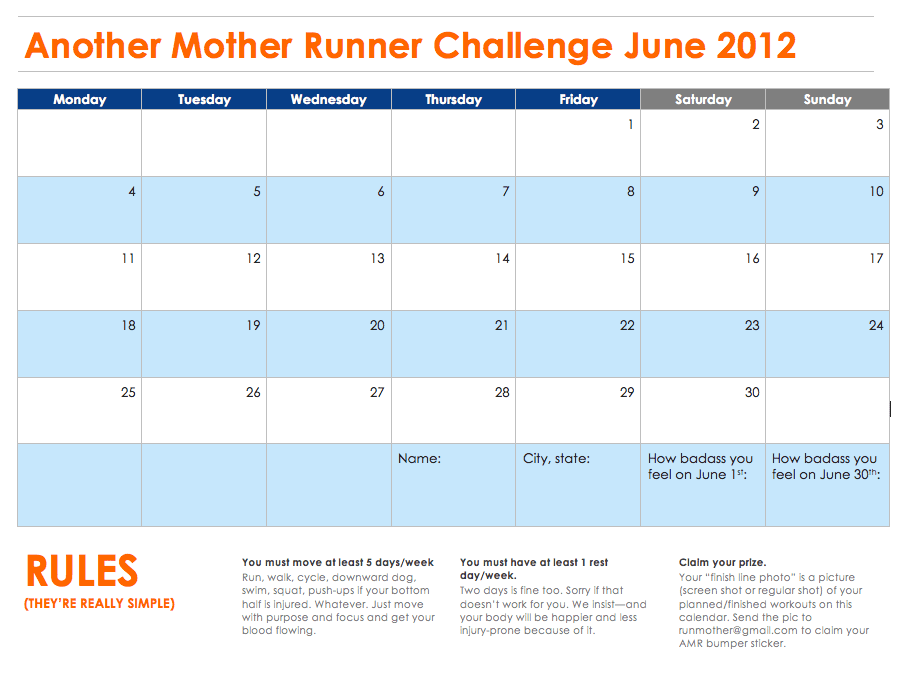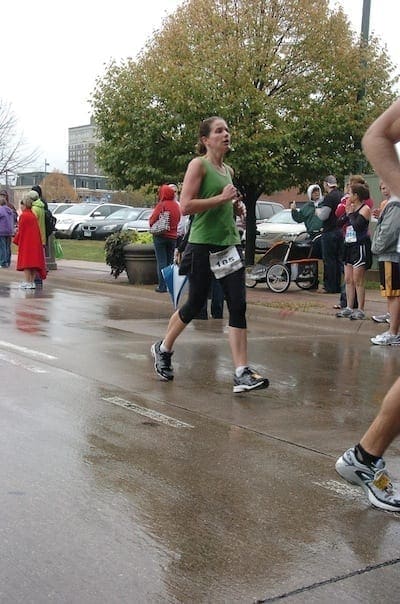Another Mother Runner Challenge!

Feel free to drag and drop this baby anywhere you want in social media land. Pin it, tweet it, facebook it, blog it. Thanks in advance.
On June 1st, we’re launching what we hope will be the first of many Another Mother Runner challenges. Why now? Because it’s almost June, the sixth month of the year; have you seen your New Year’s resolution lately? Also, school is getting out, so it may become harder—but sooo much more necessary (hello, patience!)—to find time to exercise. Finally, we thought you needed something else to keep track of. Because we certainly do.
How does the Another Mother Runner Challenge work?
You download this word document (.doc) of the month of June, and write or type in your workouts for at least 5 days of each week. (If that format doesn’t work, here it is in .pdf form as well.) We insist that one day a week be a rest day, and if you’ve raced or are staring down a crazy busy week, two days off is cool as well.
Should I fill in the whole month now with workouts?
Ideally, yes. That way, you have to look at your schedule, think through your month, and figure out a way to squeeze around those workout-squashing landmines. But if you have to take it week by week, we get that. Do try to plan in advance though, as there’s something crisply rewarding about having a plan, then getting it done. (Vs. the wishy-washy alternative: What should I do today? Run? Strength Train? Elliptical? Nothing? O.k., nothing wins.)
What if I’m already on a training plan?
Totally fine, especially if you’re on one from Train Like a Mother: How to Get Across Any Finish Line – and Not Lose Your Family, Job, or Sanity. Just pencil or type in a month’s worth of workouts from the training plan to the AMR Challenge calendar, and follow along.
Do I have to run?
Nope. You have to move with determination and focus. (Read: Duck, Duck, Goose with your kiddos doesn’t count.) If you’re injured, we don’t want to send you deeper into a hole. Some non-running suggestions: cycling, swimming, pool running, yoga, spinning class, Pilates, P90X, Zumba class, a DVD, strength training routine, push-ups if your bottom half is totally out of commission. You get the idea.
Is there a way to stay accountable?
Glad you asked because actually, there is. AMR Connect, our password-protected forum, is ready and open for chatting, helping, cheering on. Every Wednesday and every Saturday, one of us will post something on the forum to have you check in, so to speak, if you want to. No pressure if you don’t get there, but as we all know, it takes a village to build another mother runner.
Note: if you sign into AMR Connect and don’t get a password, please check your spam.
Can I take the AMR challenge with a pal?
Absolutely. No better way to get your glutes out of bed at 5:15 on a Tuesday morning than to know your BRF is waiting for you. But you both have to have your own calendars and both do all the workouts. But you probably knew that already.
What do I get if I finish the AMR challenge?
What? The strength and fulfillment that comes with a solid month of exercise isn’t enough? Kidding. For this inaugural challenge, we’re offering a free Another Mother Runner bumper sticker to anybody who finishes. We’ll even ship it for free. We’re hoping to up the ante for the next time, but this is a testing, testing, testing round.
How do you know if I’m entered?
Please visit AMR Connect once before June 1st to let us know you’re in.
How do you know if I finished?
You send picture of your finished calendar—either a screen shot from your computer or a shot from your phone or real camera—by Tuesday, July 10th to runmother [at] gmail [dot] com along with your shipping address. We’ll trust you did the work.
Have another question?
Chances are, somebody else has the same one. So post it below in the comments or in the AMR Connect, and we’ll get ‘er answered.
Five Out-There Race Series

Looking fierce: Mother runner Ashley (tutu’d gal far right), her teammates, and her hubby getting muddy in a 2010 Warrior Dash
As we approach the end of the spring half- and full marathon season, it’s time to think about mixing things up a bit this summer. It seems every time we turn around, a new, wacky race series has sprung up–events that include colorful paint, foam, obstacles, water, mud, fire, or sometimes a combo of almost all of these things. Whether you’re looking for a few laughs, a fun family activity, or a break from a training plan, give these races a look-see. (Many of them have a kids’ race, too.)
5KFoamFest: While this sounds a little risque (or maybe it’s just my pervy mind), it’s good, clean fun. Well, with a little mud mixed in. These races are, you guessed it, 3.1 miles in length with 15 to 30 obstacles set up along the way, including climbing up and over walls, rope nets, and hay mountains. There are several water obstacles, with our fave being the “Ginormous Slip ‘n Slide.” Participants can opt out of any challenge that looks too, well, challenging. Eleven more race dates this year, from Texas on west.
Color Run: A, ahem, bright idea for a race, this 3-mile moving party requires participants to wear a white shirt. Then there are “color zones” at five intervals along the 5K course where volunteers pelt runners and walkers (all paces welcome) with non-toxic, “magical color dust.” This race emphasizes fun: You can sign up as a team to help your friends or family get their color on, and strollers are welcome. Nationwide series with 36 venues (although many are sold out). (Similar race is Color Me Rad.)
Hero Rush: This new race series involves a firefighter-themed 5K obstacle race that allows for anyone to experience what it is like to be a firefighter. Participants climb ropes, navigate through confined spaces, drag equipment, slide down poles, and even possibly perform CPR. Course are at least 5K. Even spectators can take part in the action, getting to do challenges that aren’t part of the course. This series has a strong charity component, supporting, in particular, the National Fallen Firefighters Foundation. Nine more 2012 venues in this national series. (Use the code “anothermotherrunner” to get 15% off entry fee for any one of the races in Hero Rush.)
Muddy Buddy: Grab a friend for one of these races, that allow participants to either run or run-and-ride, taking turns but staying together the entire race. If you and your pal opt to run the entire way, you’ll cover 3 to 4 miles and tackle 8 to 10 obstacles; if you go for the run-bike race, you run while your friend rides, then switch back and forth during the 6- to 7-mile race that has five obstacles. Both races culminate by crossing a 50-foot mud pit. Eight races nationwide.
Warrior Dash: You’ve probably heard of this dandy, which the organizers bill as the “world’s largest running series” (despite its website being heavy on photos and video, lite on details). The course is loaded with obstacles, including the infamous fire that participants jump over. Costumes are strongly encouraged, and each over-21 participant gets a beer post-race. This nationwide series has a slew of race locations.
You Asked for It: Another Q&A Podcast
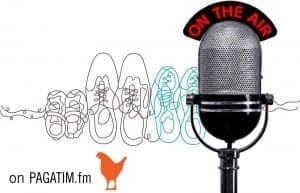
Mentioned in this episode: The Country Music Marathon playlist by Dimity, and the Boston Marathon playlist by Sarah.
If you’re digging our podcasts, we’d be super-grateful if you’d take a minute (because we *know* you have so many to spare!) to write a review on
**Also, the quickest way to get our podcasts is to subscribe to the show via iTunes. Clicking this link will automatically download the shows to your iTunes account. It doesn’t get any simpler than that!
***Or visit our great friends at Stitcher and subscribe to our podcasts there. Stitcher has been nominated as one of the best Apps ever.
“Running Saved My Life.”
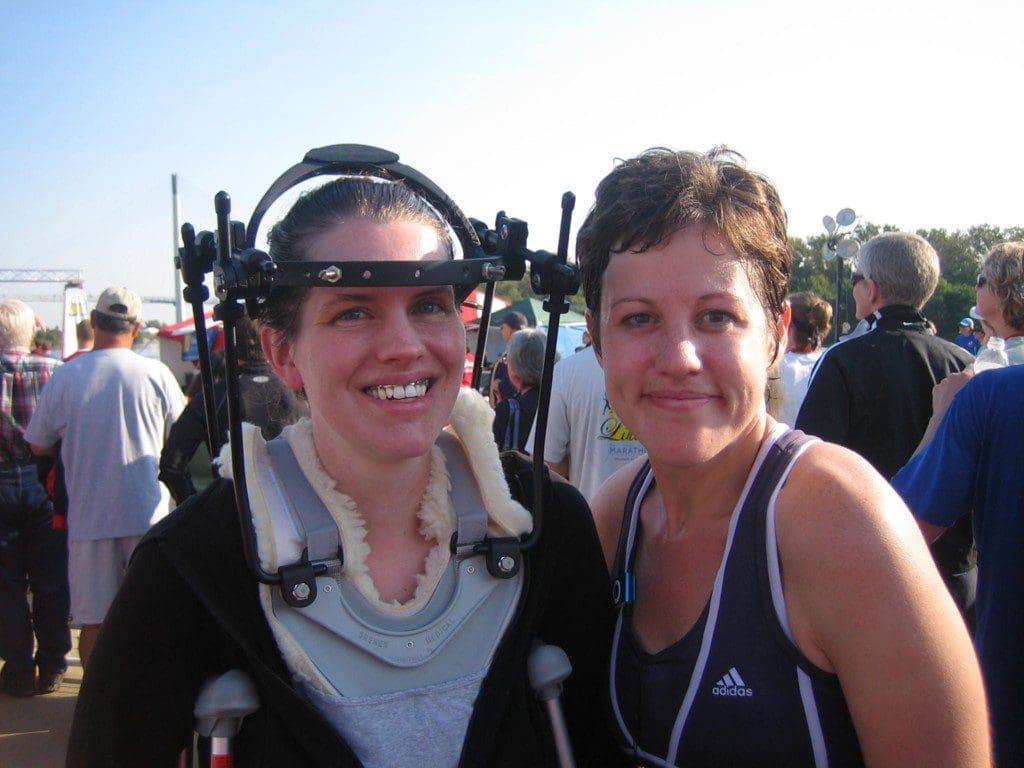
Courtney and her pal, Stacy, after the 2009 half-marathon they were supposed to run together. Post-race, Stacy gave Courtney her medal.
I came across Courtney Moose’s story on Facebook somehow last spring, but it took a while for us to connect and get her (amazing) story out there. I’m so glad we can finally share it.
A 37-year-old mother of two and family practice doctor in Brandon, South Dakota, Courtney also calls herself an on-and-off-again runner since college. “Life is busy,” she says, “I got married after my first year of med school, had my daughter first year of residency, then had my son less than a year after I started my practice. I kept running here and there, kind of in spurts.”
In May of 2009, Courtney ran a 10K with her friend Stacy, who convinced her to train for a half. They set their sites on the Omaha Half in September 2009. “On July 26 we ran our first 10-miler and were so proud of ourselves,” she says, “We felt that we were actually going to be able to do this.” Unfortunately, she would not have a chance to cross that finish line.
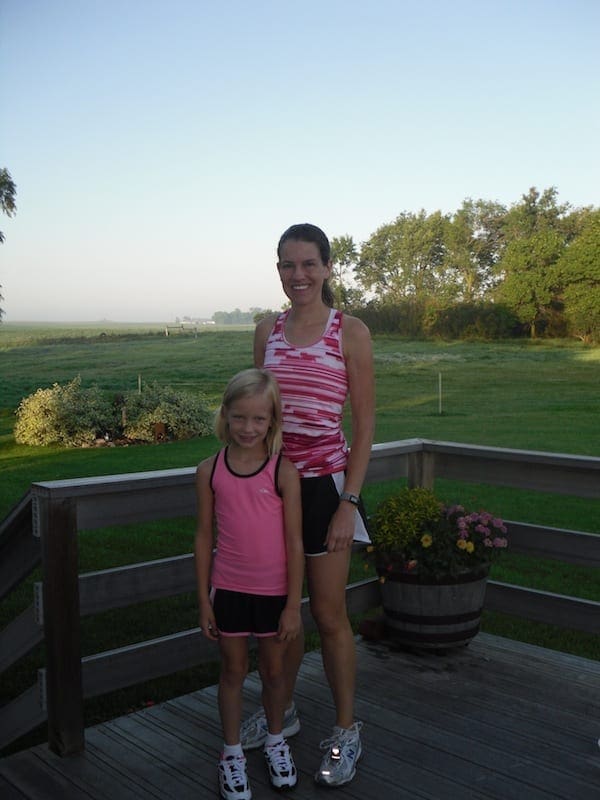
“Right before a race in July 2010. It was the anniversary of the day things were really bad; I was still in the ICU and my husband was told that running was the reason I was still alive. I ran a 10K that day, and my daughter Natalie, then 7, ran the mile.”
Two days later after her victorious ten-miler, as she was heading home from work for her afternoon off, her Yukon got t-boned by a semi that ran a red light at 50 mph. It smashed right into her door. The result? 23 fractures including all 7 cervical vertebrae, 2 thoracic vertebrae, and 4 pelvic fractures; many internal injuries that caused her to spend 5 hours in surgery that first afternoon; and 13 weeks of wearing a halo.
Three years later, she reflects on that time on her life–and how she came out the other side.
How did running save your life? I had severe lung contusions, among other issues, and was on a ventilator for 10 days. I also developed pneumonia a few days after the accident. Things were not looking good. That is when the trauma surgeon who took care of me told my husband that running had probably saved my life; my lungs and heart were so strong from running that they were somehow managing to continue working despite the almost fatal lung injuries.
What was the hardest thing about your recovery? When I realized just how bad things were. One day after I was moved to the inpatient rehab floor, I was lying in bed and the phone in my room started ringing. A phone rings, and you answer it, right? Unless you have 23 fractures. I counted 25 rings and I could not get to the phone, which was a whole 2 feet from me. I simply could not get there. I remember thinking that less than a month earlier, I had run 10 miles, and now I could not get to the phone that was 2 feet from me in 25 rings. How in the world was I ever going to get back to taking care of myself, let alone my kids and my house, and running? That was a dark moment.
Do you remember your first run back? I got the OK to start running again in January, 6 months after the accident. Of course, January in South Dakota is not ideal outdoor running conditions. My first runs were on the treadmill in my basement, and on the track at the gym. Not the most beautiful of scenery, but I was running!
Did you make it to that half? Yep. I ran it in September of 2010, then ran the Quad Cities Marathon in September of 2011. If you asked me before my accident about running a marathon, I would have said “NO WAY.” But the accident completely changed my outlook and running became much more a part of me and who I am. As I crossed the finish line, my first thought was: Take that semi! I called my husband shortly after I finished and then texted the orthopedic surgeon who placed the halo, fixed my terrible arm fracture, and dealt with my pelvic fractures to thank him for all he did to get me there.
What’s up next? The Chicago Marathon in October. I’m hoping to beat 3:59:04, my time for the Quad Cities Marathon.
What’s your perspective now on running? Little did I know in May 2009 what I really was training for. It wasn’t a half marathon. When I began to realize how close I had come to dying, and that running probably saved my life, I knew I had to get back to it. After 6 weeks in a wheelchair, 6 more weeks on crutches, and 13 total weeks in a halo, I got back to life, and running became more important to me than it ever had been. Thanks to running I’m here to see my kids grow up!
Tell Me Tuesday: Overcoming Fear of Flats
I’ve been riding ____________ (still unnamed bike) quite a bit these days, and–knock on wood–have not had a flat tire yet. But I know that day will come, and I will be left, probably in tears, as I take 30 minutes to do what most cyclists can do in 5. I wrote this story about how I suck at changing flats for Bicycling magazine at least five years ago, and, sadly, it applies as much today as it did when they published it.
I felt invincible pedaling across the George Washington Bridge on my brand-new, triple-chainringed red wheels, the first bike I’d owned since my three-speed Schwinn 15 years prior. The day before, I had taken a few laps of Central Park, clicking my first pair of cleats into and out of the pedals, the only mechanical skill I thought I needed for my new wheels. I was reveling in seeing the pavement fly beneath me, until I heard a “psssst” coming from my front wheel. The thought crossed my mind that it wasn’t a good noise, so I turned around but kept pedaling, confident I could cover the 5 or so miles back home to New York City. Wrong. Within a few more pedal strokes I stopped dead on the rim. I clacked 400 yards to a gas station, tears streaming down my cheeks, feeling as if I was stranded with nobody around for hundreds of miles, and not in suburban New Jersey on Route 9W, cars flying past.
I stood at the station for a while, wondering if the air pump could somehow reinflate my tire. (I had no idea there was a tube in there, or that it had something called a “presta valve,” which wasn’t compatible with the pump’s chuck.) Too embarrassed to ask for mechanical help from the attendant–a good decision, in hindsight–I asked him for a phone book. Twenty minutes later I stuffed my bike, wheels not released (I had no idea they did that), into the back seat of a taxi, jumped into the front seat and bit my cheeks so I wouldn’t cry in front of the cab driver.
When I told my boyfriend, Grant, about my adventure over the phone, he didn’t judge me for being so–what’s the word?–stupid. Instead, that night, he brought over a seatbag, a minipump, tire levers and spare tubes for my new red ride. He knew enough about me, still clearly stinging from my ignorance, not to offer instruction; instead, he quietly fixed my flat. I can’t remember if I had told him at that point in our relationship that I loved him, but I definitely knew for sure then.
He eventually became my husband and, not surprisingly, my bike mechanic.
Fast-forward 10 years, and I know how to change a flat, kind of. Grant eventually taught me. But out of the 10 or so times I’ve flatted, I’ve fixed it successfully just once without any help. Because of flats I couldn’t figure out, I have: hitchhiked on Interstate 25 outside of Santa Fe, New Mexico; waited on the 3-mile loop of Brooklyn’s Prospect Park for Grant to lap me and realize I was no longer behind him; called Grant on my cell phone at least five other times to drive to me either to change my tube or take me home.
I’m a girl–in a stereotypical sense that my empowered, post-Title IX ego has trouble accepting. Anything remotely mechanical is a mystery to me. I am intimidated by power tools. I do not know where to pour oil into my car. I have no idea what purpose a derailleur serves on a bike.
The thing is, I’m a good cyclist. As a former elite rower–my crew won the junior world championships in 1995–my quads have some serious horsepower, even though they’ve shrunk a few sizes over the years. I have completed two half-Ironmans, and I flew through the Santa Fe Century, feeling stronger at mile 90 than I did at mile 15. At my last indoor power cycling class at Carmichael Training Systems, I averaged 278 watts for eight minutes, about what Grant can pull. I’ve taken the hard-core preseason class for the past two years because I’m intrigued by how strong I can be as a cyclist, and because it takes place in a contained environment where I can’t be stranded by a flat.
I’ve never put my power to the road with any regularity because of my anxiety toward that confounding, beastly machine. In fact, I rode outdoors exactly three times last summer, only on occasions when I was either with a group or Grant was on call. My attempts at changing flat tires are dirty, ugly, frustrating affairs that cause such resentment toward my bike that I often leave it racked for months afterward. Lying in bed one night, pondering my complicated relationship with cycling, I said to Grant, “I mean, I can change a flat, but I just don’t like to.” He replied, “No, I’m pretty sure you can’t.”
He spoke the truth. And I realize that it’s time to face my demon head-on, finally. A few days later, I bring my bike to the Colorado Cyclist bike shop, in my hometown of Colorado Springs, Colorado, and put my incompetence into the very competent hands of Phil, Scott and Ryan. All are dressed in the requisite bike-shop-dude outfit: dark jeans, black T-shirts, hipster sneaks. “I suck at changing flats,” I blurt, “and I don’t ride my bike because of it.” I feel raw admitting it, but I imagine it’s not unlike standing up at your first AA meeting and introducing yourself. After you own your flaws in front of strangers, the healing can begin.
Phil hoists my bike up on a workstand and begins changing my back tire. He removes it–no grease on his hands at all–and walks through the process as if he’s doing something as second nature as brushing his teeth. In between snippets of instruction, he tosses around insider bike terms such as snakebites, beads and lawyer tabs. At first I nod reflexively, trying to show him that I know what he’s talking about. But then I catch myself, remembering where ignorance has gotten me over the years. I suck it up. “What is that?” I ask. “Can you explain in layman’s terms?”
He complies, and slowly what seemed like a foreign language begins to make sense: A snakebite, also known as a pinch flat, is the kind of flat you get when your tire is underinflated and you hit something hard, like a rock or pothole, that pinches the tube against the rim, often causing two parallel holes, like a snakebite. (The opposite is a puncture flat, when you run over something sharp.) Beads are the edges of the tire that fit into the rim; most are made of flexible Kevlar, although older and cheaper tires have finger-ripping wire beads. Lawyer tabs are tiny notches on the fork that prevent the wheel from coming off even if you don’t install it correctly; the name stems from the fact that they supposedly minimize bike–related lawsuits. I take comfort in learning that so many people don’t know how to mount a front wheel that an idiot-proof device was created to save them from themselves.
As Phil demonstrates, his hands work as capably and nimbly as a cardiovascular surgeon’s. He knows instinctively at what angle to rest the wheel on his quad to make it easy to get the tire off; he can stuff the tube, which he’s blown up a bit with his mouth, back into the tire seamlessly; he can reattach the back wheel, it seems, with his eyes shut–all in a couple of minutes.
When it’s my turn to try, I have to think way too hard even about what direction to push the pedal with my hand as I shift to a small cog to make it easier to remove the wheel; understanding how things move in space is not my forte. My hands are already black with grease when I finally wrangle the wheel free. The tire comes off without the use of tire levers, because brute strength is one of my assets. But pressing the new tube into the tire, I feel like I’m at Chuck E. Cheese’s, playing Whack-A-Mole, the game where you hit one mole and another pops up somewhere else. I fit the tube snugly into the tire in one spot, only to have it spit out in another. I feel my face burn red but hope the guys don’t notice. One of them–I can’t bear to look up and see who it is–moves in for the assist, and eventually the tube lies flat in the tire. I squeeze the tire back onto the rim, Phil pumps it with the floor pump, and I’m just relieved it’s done so I can go back to watching, not doing.
But it’s not done. I still have to mount the wheel back onto the bike. Again, my spatial cluelessness kicks in, and I jam the wheel somewhere between the derailleur and the chain, hoping it’ll be the right place. It isn’t, and another assist gets me off the hook.
Because the tire came off without levers and because, apparently, I did well enough on that attempt–were they asleep?–Scott brings out a brand-new wheel with a brand-new tire, which means the tire is on so tight that it’s impossible to get it off without levers. So after a helpful demonstration from Phil, who has slowed the pace of his instruction and dumbed down his vocabulary considerably, I plunge a blue plastic tire lever between the rim and the tire, push the lever downward to lift the bead, and hook the end of the lever to a spoke. In less than a minute, I have the tire off. I’m unbelievably proud of the small feat and go on to change this pseudo-flat much more smoothly than the first time.
Therein lies the key: Competence is built only on knowledge and practice. It is boring and clich? yes, but the fact remains that I can’t will or force or fake my way into being more comfortable changing a flat. I just have to take what I learned today, and change and rechange flat tires, somewhere preferably other than the stress-charged side of a road. Only in the repetition, and putting as much energy into it as I’d give a workout, will I gain the confidence to take to the streets solo.
The next evening, I tee up four episodes of “Entourage” and, on my living-room floor, I prepare to flat at least eight times, two on the front wheel, six on the bitch–I mean back. I will force myself to take on the full monty each time, from taking the wheel off the bike to pumping the tube back up and reattaching the wheel. On the first change, I’m “Was that lesson a mirage?” clumsy, but by number five I’m finding a rhythm. My skills are far from pretty, but they’re also far from my initial incompetence.
After two rockin’ nights at home practicing and 16 fake flats fixed, I feel ready to head outside. I’m surprised by how light and untroubled I feel as I pump up my tires myself–a task Grant has done for me for at least six years–then stuff a tube and my cell phone into my jersey pockets. “I’ll fix one flat myself,” I tell Grant as I roll out from the garage, “And then I’m calling you.” But I don’t need Grant, nor do I need my newfound ability. I arrive home, both tires still plump, and realize I’m actually kind of bummed I didn’t get a flat tire.
Still, let’s be honest: I’ll never be what others would consider good at changing a tube. I’ll definitely never leave home without my cell phone. But I will leave home, pedaling as far and as fast as I want to, even if I reach a point where the bars on my phone have disappeared and I’m out of range of my mechanic.

Part of Trek’s super helpful step-by-step manual. Trust me: unless you’re a mechanical whiz, you want this in your bag.
The good news? I’ll never be as stranded as I’ve been before. Trek has this great little, how-to-change-a-flat, illustrated guide which I’ve ripped out and put in my saddle bag with my tubes and CO2 cartridges. You can do the same; here’s the pdf of it.
Are you better at changing flats–or at least not worrying about them–than I am? How did you get there?
Tell Me Tuesday: Dealing with Your Period on Race Day
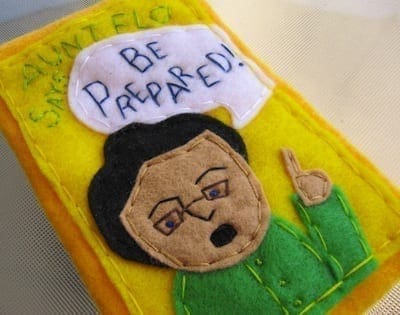
What we–and the Boy Scouts–recommend for dealing with your period on race day. (Get it…”be prepared.”)
One of my favorite anecdotes in Run Like a Mother: How to Get Moving–and Not Lose Your Family, Job, or Sanity is from Megan, who tells of getting her period on marathon morning. She was so ticked off, she pushed hard enough to qualify for the Boston Marathon. (Nicely done!) It’s happened to us all: You train your butt off for a race, then Aunt Flo shows up for the ride. No fun.
Given that we are pretty much in the height of training and racing season, I figured it was time for some tips for dealing with running on the rag–or how to avoid it entirely. (An obvious warning: TMI ahead!)
–Shorten the string. Women have complained to us about chafing from a tampon string. (Yeah, we hear it all–we love nothing better than a good overshare!) One mother runner, Christine, told us cuts it shorter so that no string hangs outside her body. I took to knotting my OBs and snipping the string–then wondered why it took me 20+ years to figure out that simple trick. Another chafe-avoiding tactic we’ve read about online: Liberally apply BodyGlide to the string hanging outside your body.
–Investigate the Diva Cup, a menstrual cup used in lieu of a tampon or pad. One can hold the flow for up to 12 hours so bring on that ultra or 70.3 race. (Like the next option, this one isn’t for the squeamish.) Another mother runner Christy Zuzelo is a fan; here’s a post she wrote about it.
–Go with the flow. Monica complained about the discomfort of wearing a tampon on a long run (we didn’t ask for any more details–had something to do with, um, drying her out). So when she runs long, or races, on lighter flow days, she pulls the plug right before she starts running (and wears black bottoms so any spotting isn’t visible). Not an option for neatniks, but when you figure your capris get pretty nasty with sweat, little blood isn’t going to make that much more of a mess.
–Consider changing the timing. You can’t rejigger the day of a big race, but you can alter the date of your period, if you’re on birth control pills (or the patch or the ring). Instead of taking the placebo pills for a week, start a new pack instead; this will make you skip a period. Our favorite mother runner OB/GYN, Amanda Hurtubise, recommended this one, saying, “Any nurse at your trusty OB/Gyn’s office is an expert at this–call her for further instructions if this doesn’t make sense.” For a longer-term solution, you could also look into Seasonique, a birth control pill that makes a woman only have four periods a year, or an IUD.
–Pop pills. Dr. Hurtubise gave us this news-to-us suggestion. “For women who are not on hormonal contraception a great trick is, ‘scheduled ibuprofen.’ Take 600-800mg three times a day, 1-2 days immediately prior to and during the period. Non-steroidal anti-inflammatories (NSAIDs) constrict the blood vessels to the uterus and can significantly decrease menstrual flow. The key is to take it consistently 3x daily prior to and during bleeding. It won’t work if just taken haphazardly. This trick will also help with any cramping.”
–Don’t forget supplies. Pack some spare tampons in a baggie and stash them in a pocket or hydration belt. Also, learn from a gross-out tale from Jennifer, who got her period as she jetted off for the Goofy Challenge at Walt Disney World. In the excitement of back-to-back races, she “lost a tampon in my innards.” (Yikes!) She visited the doctor, who told her the case of the wayward tampon was not uncommon. Lucky for Jenn, it emerged on its own nearly three months later. (If tampons could talk….)
Now, it’s your turn to overshare: What are your tips for dealing with your monthly visitor during a long run or race?


